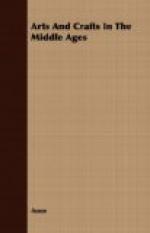Textiles of Italian manufacture may be seen represented in the paintings of the old masters: Orcagna, Francia, Crivelli, and others, who delighted in the rendering of rich stuffs; later, they abound in the creations of Veronese and Titian. A “favourite Italian vegetable,” as Dr. Rock quaintly expresses it, is the artichoke, which, often, set in oval forms, is either outlined or worked solidly in the fabric.
Almeria was a rich city in the thirteenth century, noted for its textiles. A historian of that period writes: “Christians of all nations came to its port to buy and to sell. From thence... they travelled to other parts of the interior of the country, where they loaded their vessels with such goods as they wanted. Costly silken robes of the brightest colours are manufactured in Almeria.” Granada was famous too, a little later, for its silks and woven goods. About 1562 Navagiero wrote: “All sorts of cloth and silks are made there: the silks made at Granada are much esteemed all over Spain; they are not so good as those that come from Italy. There are several looms, but they do not yet know how to work them well. They make good taffetas, sarcenet, and silk serges. The velvets are not bad, but those that are made at Valencia are better in quality.”
Marco Polo says of the Persians in certain sections; “There are excellent artificers in the cities, who make wonderful things in gold, silk, and embroidery.... In veins of the mountains stones are found, commonly called turquoises, and other jewels. There also are made all sorts of arms and ammunition for war, and by the women excellent needlework in silks, with all sorts of creatures very admirably wrought therein.” Marco Polo also reports the King of Tartary as wearing on his birthday a most precious garment of gold, while his barons wore the same, and had given them girdles of gold and silver, and “pearls and garments of great price.” This Khan also “has the tenths of all wool, silk, and hemp, which he causes to be made into clothes, in a house for that purpose appointed: for all trades are bound one day in the week to serve him.” He clothed his armies with this tythe wool.
In Anglo-Saxon times a fabric composed of fine basket-weaving of thin flat strips of pure gold was used; sometimes the flat metal was woven on a warp of scarlet silk threads. Later strips of gilded parchment were fraudulently substituted for the genuine flat metal thread. Often the woof of gold strips was so solid and heavy that it was necessary to have a silk warp of six strands, to support its wear.




